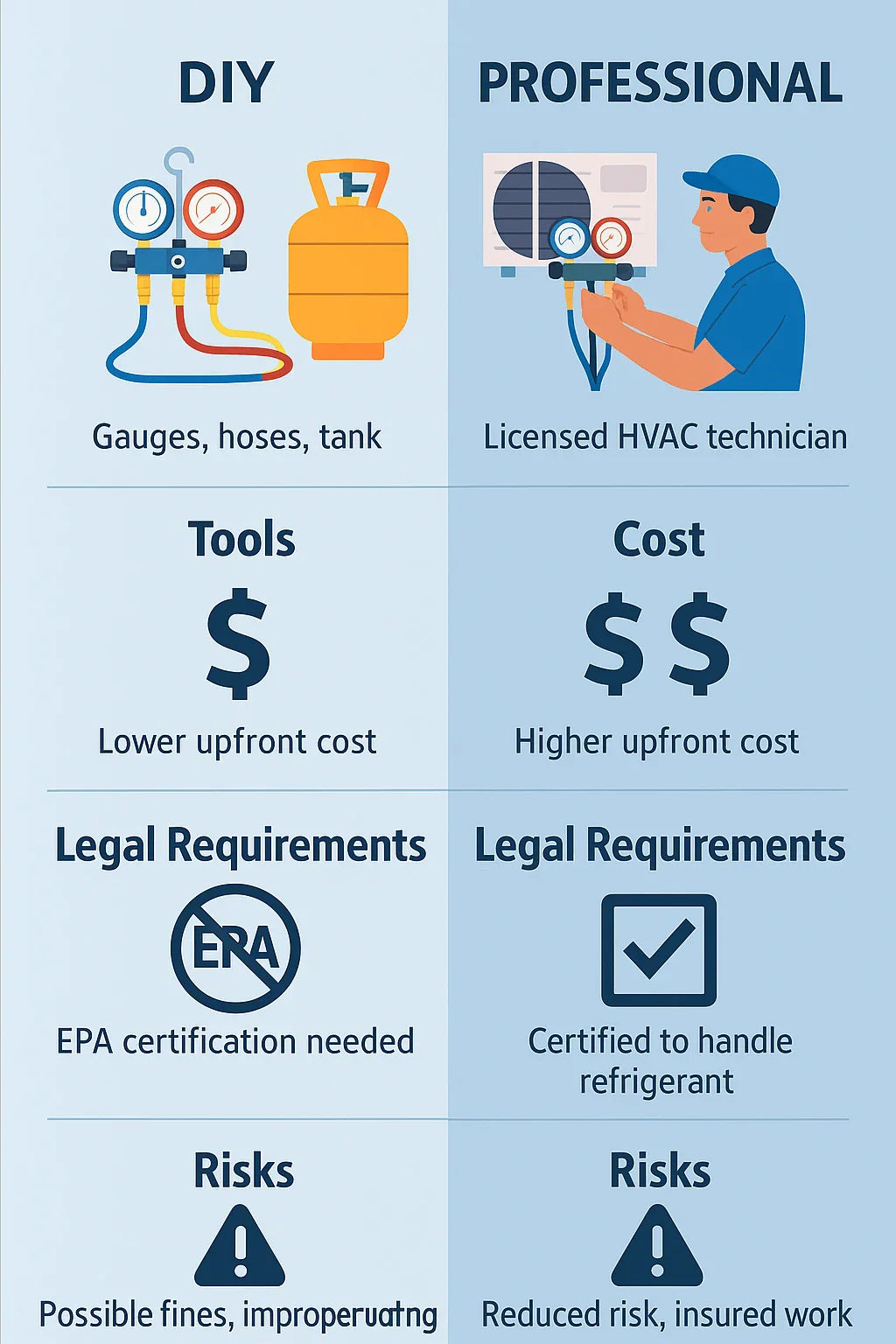If you’ve ever researched installing or servicing your own heat pump, you’ve probably run into a big question: Can I charge the refrigerant myself, or should I hire a professional?
Refrigerant charging is one of the most critical — and most regulated — parts of heat pump installation and maintenance. Done correctly, it keeps your system running efficiently, reliably, and safely. Done wrong, it can damage your equipment, harm the environment, and even put you at risk of injury or fines.
In this guide, I’ll break down what refrigerant charging involves, the pros and cons of DIY vs. hiring a pro, cost comparisons, and the legal requirements you need to know before deciding.
For a full overview of the installation process from start to finish, see the Complete Guide to DIY Heat Pump Installation.
What Refrigerant Charging Involves
The Purpose of Charging
Refrigerant is the lifeblood of your heat pump. The right charge ensures the system can efficiently transfer heat in both heating and cooling modes. Too much or too little refrigerant can lead to poor performance, higher energy bills, or even compressor failure.
Tools Required
To charge a heat pump, you’ll typically need:
-
Manifold gauge set
-
Vacuum pump
-
Micron gauge
-
Refrigerant scale
-
EPA-approved refrigerant
📘 The U.S. Department of Energy warns that incorrect refrigerant levels can cut efficiency by 5–20% and cause long-term damage to the system.
Why Precision Matters
Even a small deviation from the manufacturer’s specified charge can cause major issues, from iced-up coils to high head pressures that strain the compressor.
DIY Refrigerant Charging
Some homeowners are drawn to the DIY approach for the cost savings and the satisfaction of doing the job themselves.
Pros
-
Labor savings – You avoid the hourly rates of HVAC technicians.
-
Flexibility – You can work on your own schedule.
-
Learning experience – You gain valuable skills for future maintenance.
Cons
-
Legal restrictions – In the U.S., you need EPA Section 608 certification to purchase or handle most refrigerants.
-
High skill requirement – Mistakes can be costly and dangerous.
-
Warranty risk – Many manufacturers require professional installation and charging to keep the warranty valid.
DIY charging is most feasible for pre-charged systems like some MrCool DIY mini-splits, which are designed for homeowner installation without the need for refrigerant handling.
Professional Refrigerant Charging
Hiring a pro isn’t just about getting the work done — it’s about ensuring the system is charged to exact specifications and verified for leak-free performance.
Pros
-
Proper equipment – Pros use advanced tools like digital gauges, recovery machines, and leak detectors.
-
Expert diagnostics – They can identify other issues like airflow restrictions or electrical faults.
-
Warranty protection – Most brands require pro installation and charging for warranty coverage.
Cons
-
Higher upfront cost – A service call for charging can run $150–$450.
-
Scheduling – You may have to wait for an appointment, especially in peak heating or cooling seasons.
📘 Energy Star’s HVAC Installation Guidance notes that correct refrigerant charging helps systems meet their SEER2 ratings, improving performance and reducing operating costs.
Cost Comparison
| Approach | Average Cost (USD) | What’s Included |
|---|---|---|
| DIY | $100 – $300 | Tools, gauges, refrigerant (with license) |
| Professional | $150 – $450 | Labor, refrigerant, diagnostics |
📘 HomeAdvisor’s Refrigerant Recharge Cost Guide gives detailed pricing for different refrigerant types and scenarios, including R-410A and R-22 systems.
While DIY may look cheaper, the cost of buying tools — plus the risk of mistakes — can offset your savings if anything goes wrong.
Safety and Legal Considerations
Refrigerant charging isn’t just a technical skill — it’s regulated for safety and environmental reasons.
-
Certification requirements – In the U.S., handling most refrigerants requires EPA Section 608 certification.
-
Fines and penalties – Improper refrigerant handling can lead to legal consequences.
-
Health risks – Refrigerant exposure can cause frostbite, respiratory issues, or eye injury.
-
Environmental hazards – Venting refrigerant damages the ozone layer and contributes to climate change.
📘 OSHA’s Compressed Gas Safety Guidelines outline PPE and safe handling practices for working with pressurized gases like refrigerants.
When DIY Might Make Sense vs. When to Hire a Pro
DIY Could Work If:
-
You have a pre-charged system that requires only mechanical connections.
-
You hold an EPA 608 certification and have the correct tools.
-
Your unit is out of warranty and you understand the risks.
Hire a Pro If:
-
Your system needs a custom refrigerant charge or uses non-pre-charged lines.
-
You want to maintain your manufacturer warranty.
-
Your system is multi-zone or has complex refrigerant routing.
-
You lack the certification to legally handle refrigerant.
The Bigger Picture: Performance and Longevity
Correct refrigerant charge is a foundational part of your heat pump’s performance. Overcharging or undercharging can:
-
Increase energy consumption
-
Reduce heating and cooling capacity
-
Cause premature compressor failure
Even if you’re confident in your mechanical skills, this is one area where paying for professional expertise often pays for itself in avoided repairs.
Final Thoughts from Alex
DIY refrigerant charging is possible in certain situations — especially for systems designed with the homeowner in mind — but it comes with serious skill, safety, and legal requirements.
If you’re working with a traditional mini-split or central heat pump, hiring a pro is often the smarter choice for long-term performance, warranty protection, and peace of mind.
Next up: Best Wall Locations for Indoor Mini-Split Units: Avoid These Mistakes — find out how placement affects comfort, efficiency, and noise control.
Alex Lane
Your Home Comfort Advocate







